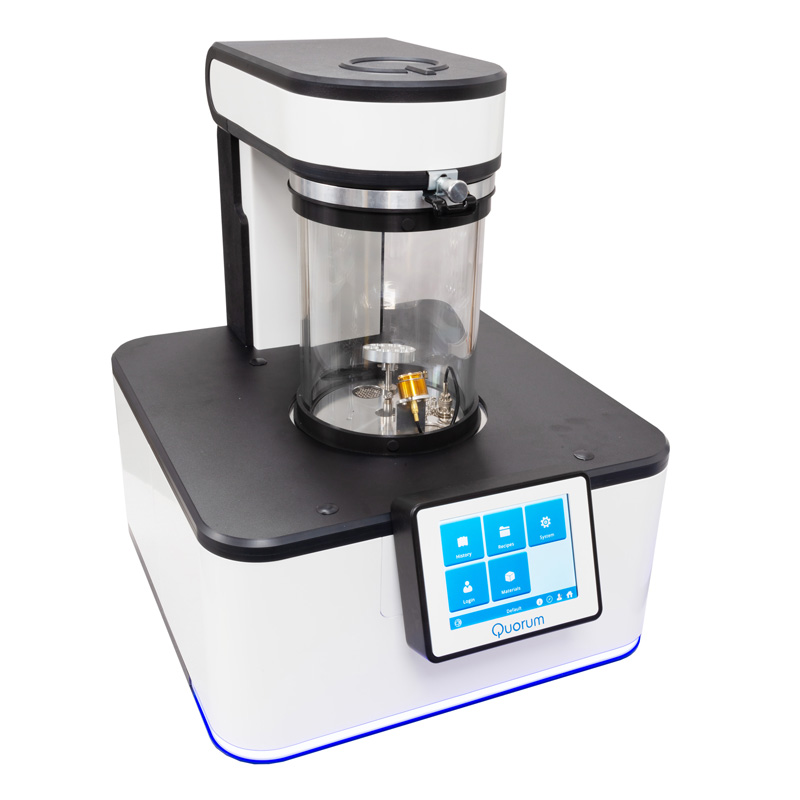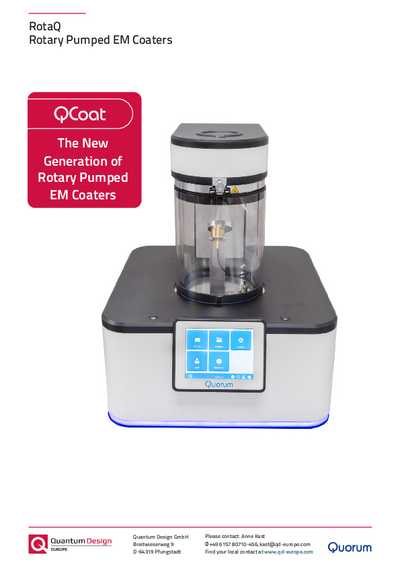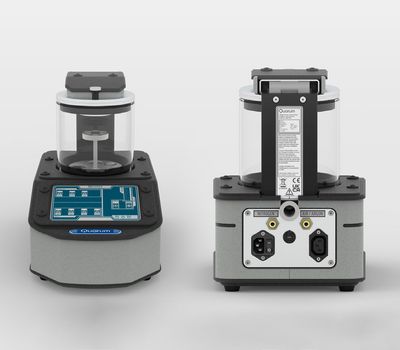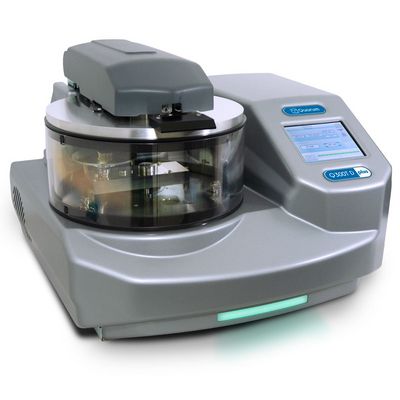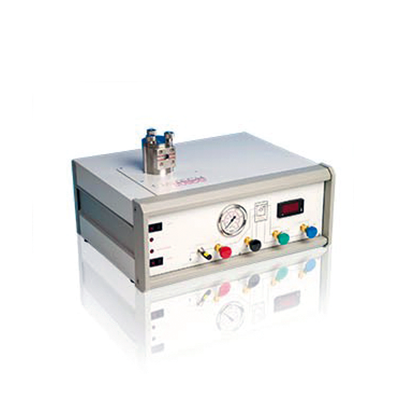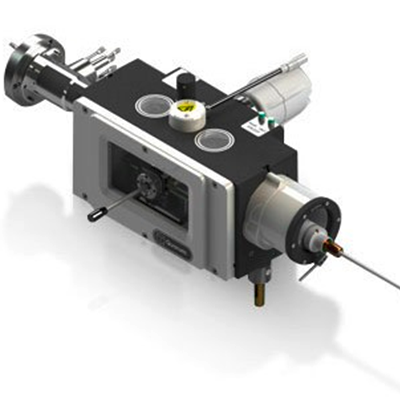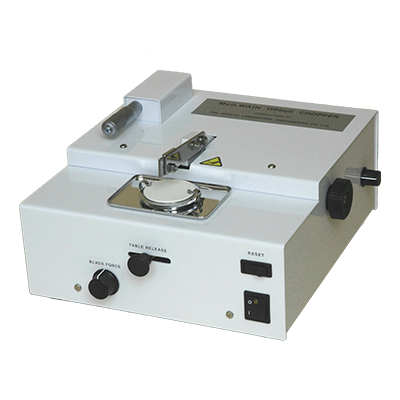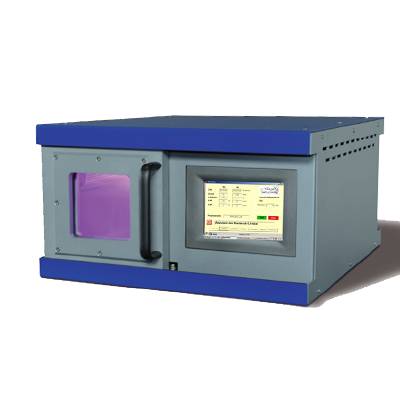Carbon and Sputter Coaters – rotary pumped
RotaQ from Quorum TechnologiesThe RotaQ series are fully automated, modular coating systems for the deposition of electrically conductive carbon or noble metal films recommended for electron microscopic applications at low and medium-high resolutions. The RotaQ can be acquired solely as a carbon coater (E), sputter coater (S) or as a combined system for carbon and sputter coating (ES).
- Fully automated coating process (incl. downloadable process log files in .csv format via USB)
- Large sample chamber: 150 mm Ø
- Fast turnover times / coating cycles
- Vacuum down to 2 x 10-3 mbar
- Film-thickness monitor included
- E: carbon fibre or rod evaporation, optional: metal evaporation set-up
- S: sputter coating of non-oxidising metals
- ES: a combined system both for sputtering and carbon coating.
Further information
The RotaQ series is available in three configurations:
- RotaQ E – an automatic carbon cord coater, can be optionally fitted to evaporate metals
- RotaQ S – an automatic sputter coater for non-oxidising metals, can be optionally fitted with a glow discharge insert
- RotaQ ES – a combined system both for sputtering and carbon coating.
The different head plates can easily be exchanged within seconds. The unit recognizes the replacement and the operating menu changes accordingly. A touch screen is used to enter coating parameters, display the coating sequence and show error messages. Multiple users can store up to 1000 recipes including all parameters. By awarding access rights, selected parameters can be protected against deletion and unauthorized modification. Only the administrator has access to all settings. A USB-port allows the download of recipes and process logs.
Several optional sample stages ensure the efficient and reproducible coating of samples within a wide range of geometries.
The fully automated process does not require tedious adjustment of a needle valve to control argon gas flow. Instead, the user can control the process vacuum, gas flow is adjusted automatically. Depending on the set gas value (vacuum), the voltage is adjusted accordingly and the desired sputter current (mA) is kept at a constant. This way, samples with strongly irregular topography can also be uniformly coated at low sputtering currents.
The glass chamber can be completely removed, granting easy access to the sample stage and facilitating the cleaning process.
Operating principle: carbon coater
Thin conductive layers of carbon are generated by resistive evaporation of carbon filaments or rods. A current of up to 70 A is needed to evaporate carbon from rod or filament. The pulsed carbon rod/fibre evaporation can be controlled by using an optional film thickness monitor. By evaporating a carbon fibre, up to 20 nm of carbon film can be deposited, whereas with carbon rods, thicknesses from 3 to 15 nm can be reached.
For higher quality carbon films needed for applications like EBSD, TEM support films or surface replicas, please refer to model TurboQ.
Operating principle: magnetron sputtering
Magnetron sputter coaters (also referred to as "Cool Sputter Coaters") are equipped with a special magnet, which is located in the sputter head (cathode) near the target.
The benefits are:
- electrons are available for ionization of further process gas ions
- excessive heating is avoided
- optimisation of the utilisable target surface.
During sputter coating, a vacuum is produced in a vacuum chamber and a process gas, preferably argon, is continuously leaked into the chamber. Argon has an optimal ion size and does not chemically react with other molecules.
Within a vacuum window from approx. 1 x 10-1 mbar to 7 x 10-2 mbar, process gas atoms are ionized in an electrical field, which creates a plasma. Positively charged argon atoms are accelerated towards the magnetron head with the target (cathode) and erode target atoms, which reach all surfaces within the vacuum chamber, including the sample to be coated.
Specifications
RotaQ S / E / ES | |
| Instrument case | 440 mm B x 551 mm D x 556 mm H (total height with coating head open: 860 mm) |
| Weight | 34 kg (ES version) |
| Work chamber | Borosilicate glass 150 mm ID x 220 mm H |
| Safety shield | Polyethylene terephthalate (PET) - cylinder |
| Display | 115.5 mm x 86.4 mm (active area) capacitive touch colour display |
| User interface | Intuitive full graphical interface with touch screen buttons, includes log of the last 1000 processes and USB-port. |
| Sputter target | Disc style 57 mm Ø x 0.1 mm thick gold (Au) target is fitted as standard. (S/ ES versions only) |
Vacuum | |
| Rotary pump | 50 l/min. two-stage rotary pump with oil mist filter (order separately, see AG-DS102) |
| Vacuum measurement | Pirani gauge |
| Typical ultimate vacuum | ∼6x10-3 mbar (in a clean system after pre-pumping with dry nitrogen gas) |
| Specimen stage | 50 mm Ø rotation stage. Rotation speed 8-20 RPM. For alternative stages see options and accessories |
Applications | |
| Sputtering | 0–80 mA to a pre-determined thickness (with optional FTM) or by the built-in timer. The maximum sputtering time is 60 minutes (without breaking vacuum and with built in cooling periods) |
| Carbon evaporation | A robust, ripple free DC power supply featuring pulse evaporation or ensures reproducible carbon evaporation from rod or fibre sources. Current pulse: 1–70 A |
| Glow discharge | Operates at 100 mA in DC+ mode and 30 mA in DC- mode |
Further Information | |
| Gases | Argon sputtering process gas, 99.998% (S and ES versions), optional Nitrogen, 99.998% |
| Electrical supply | 90–250 V 50/60 Hz 1400 VA including rotary pump power. 110/240 V voltage selectable. |
| Conformity | CE conformity: Power factor correction. Complies with the current legislation (CE Certification) and ensures efficient use of power, which means reduced running costs |
Options and accessories | |
| 10879 | Carbon rod evaporation insert for 3.05 mm Ø rods (E and ES only). Includes manual rod shaper and 3.05 mm Ø x 300 mm (pack of ten) carbon rods. |
| 10262 | Glow discharge insert. Used to modify surface properties (e.g. hydrophobic to hydrophilic conversion) (S and ES versions only). Can be retrofitted. |
| 10726 | Additional sputter insert for quick metal change (E and ES versions only). NB: This is an entire sputtering assembly; individual targets can also be purchased. |
| 10360 | Variable angle 'Rotacota' rotary planetary specimen stage (rotational speed 8-20 RPM). 50 mm Ø specimen platform with six stub positions for 15 mm, 10 mm, 6.5 mm or 1/8" pin stubs. Stage rotation speed variable between 8–20 RPM. |
| 10454 | Film thickness monitor (FTM) attachment. Including oscillator, feed-through, quartz crystal holder and quartz crystals (included in the system) |
| 10429 | Extra vacuum chamber (220 mm H, 150 mm ID). |
Applications
Thin carbon layers are evaporated onto non-conductive samples in electron microscopy for applications like EDX or WDX to prevent charging of the sample. Carbon has a low x-ray absorption, assuring better detection of x-rays than with metal coatings.
Sputter coaters are used to deposit a thin metal layer on the surface of a sample/substrate. For electron microscopy applications, electrically conductive films need to be deposited on non-conductive surfaces, to prevent electrons from the microscope's electron beam from accumulating on the sample surface, causing the latter to become charged. Such a charge would prevent imaging of these surfaces with the SEM. The desired films should be extremely thin, but electrically conductive, with a thickness of 3 - 20 nm.
Glow discharge is used to alter the properties of sample surfaces. TEM carbon support films are hydrophobic after fabrication. After treatment with glow discharge, they become hydrophilic, thus allowing an even spread of aqueous solutions.
Downloads
Contact
| +49 6157 80710-12 | |
| +49 6157 80710912 | |
| Write e-mail |

| +49 6157 80710-456 | |
| +49 6157 807109456 | |
| Write e-mail |


